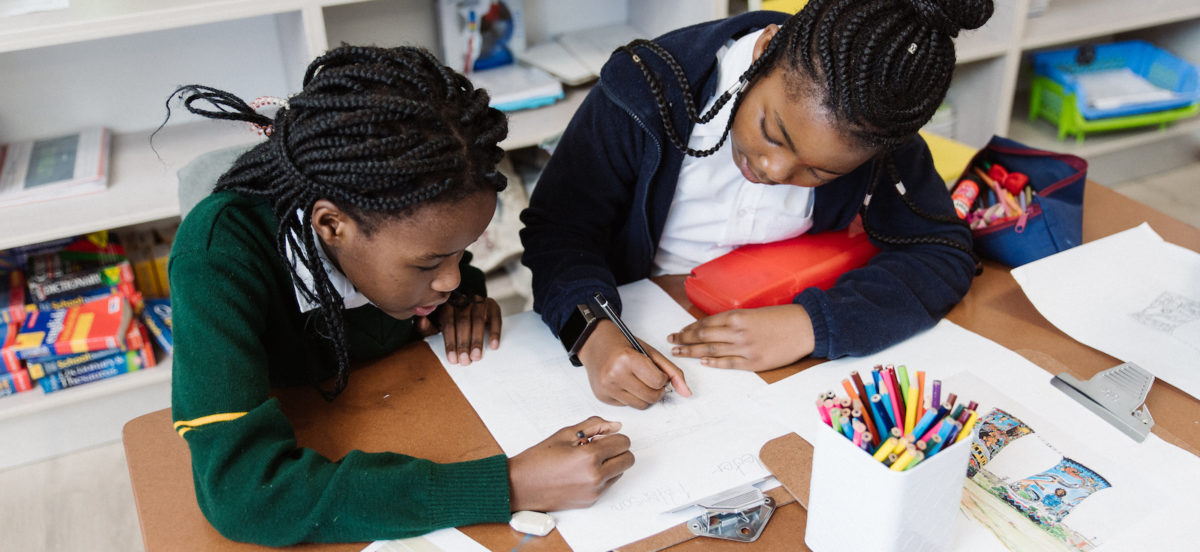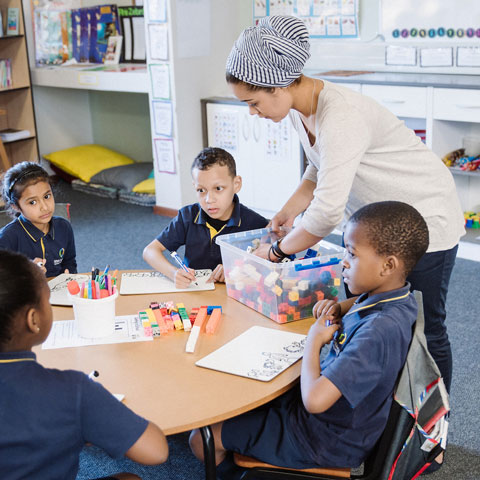What kind of schooling will your little one need for the world of tomorrow? Lisa Witepski investigates how parents and schools can help educate children for the future. (This article was first published in Living and Loving)
Hands up if you remember memorising key dates in history, or making sure you could rattle off the times table in your sleep. For most of us, this type of rote learning was the alpha and omega of the school day. Of course, we were being prepared for a world where factual recall would stand us in good stead. Our children, on the other hand, are unlikely to need this skill, because robots will do the memorising and regurgitate information for them. However, our children will need to develop other skills to help them succeed in careers we can’t begin to imagine.
Reading, writing and arithmetic
As Sameer Rawjee, founder of the Life Design Lab at Google and CEO of O-School, points out, reading, mathematics, biology and science are the building blocks of education. You can build on them and augment them, but if they’re not in place, you won’t be able to go very far.
Then again, they’re not the only requirements for success in our children’s world. Bailey Blake, head of schools at SPARK Schools says, “As the world becomes more automated, what differentiates us is the ability to collaborate and corroborate. Adaptability is also key, because our children will need to be able to fit into an ever-changing context.”
Linked to this is the notion of grit, perseverance and passion – but it doesn’t end there. Lisa Illingworth of Futureproof maintains that the skill set of the future, is encapsulated by an entrepreneurial mindset. Not just in terms of having the qualities required to start a business (although those are undeniably useful, too), but the accompanying abilities, like “being able to see the world as an integrated set of systems, and to navigate between those efficiently; being able to spot opportunities and capitalise on them to earn an income; to be able to work with, and learn from, others”. These are skills that should be taught early on. Lisa insists children as young as six years old are able to identify opportunities and qualify ideas.
For Xolisa Luthi of Future Nation Schools, it all comes down to problem solving. This might sound like a lengthy list but, says Bailey, as long as you instil a love of learning in your child, you’re halfway there . Their craving to know more about the world around them will drive them to do the rest.
As Kate Groch of the Good Work Foundation puts it, “The biggest shift that has to happen is to stop thinking in compartments where you go to school, and then go to work. Learning isn’t a period of 12 years while you’re at school, and then it’s done. Rather, there is an ecosystem of learning and working. Learning should be ongoing, so you continuously look at where you are, then reinvent yourself.”
The why and how
Bez Sangari of Sangari Education, a company which distributes augmented and virtual reality simulation for education, says “We need to stop equating education with knowledge acquisition. Education, not knowledge transfer, should be every school’s goal.”
Xolisa agrees. He suggests an emphasis on application in place of theory; highlighting the relevance of each topic and showing how it fits into their daily lives.
“Students need to transform from passive recipients of information to active participants in a personal learning process. They need to be able to construct their knowledge actively, rather than mechanically ingesting it from the teacher or online sources,” says Bez.
As part of this, Bailey says schools need to take into account the different ways children learn. While one child might thrive on visual stimuli, another might need auditory input before they can process information effectively – and, in an ideal learning environment, each of these children is accommodated.
Xolisa says that if education can be likened to a table, traditional models have been balancing (make that teetering) on two legs: students and teachers. The involvement of parents (the third leg) will make for greater balance, as we’re entering an era where parents need a little extra help when it comes to raising kids. The fourth input comes from corporates: “We need to know what kind of skills they require so we can be sure we are helping our children develop relevant attributes,” he explains.
The ideal classroom
So, what does the ideal future education model look like? Des Hugo, head of academics at Nova Pioneer, says it starts with an environment that reflects the children’s ideas, wonderings and thinking, rather than a teacher’s template.
“In a classroom environment, this shows up as artwork that is very clearly based on a child’s creativity rather than what the teacher has told them to do.” In fact, she adds, teachers should be doing a lot of asking, rather than telling, giving learners a sense of autonomy in a democratic learning environment. “It’s about getting the children thinking. The teacher may pose a question, but she’ll listen to their suggestions – and encourage them to do the same – before sharing a possible solution.” She places heavy emphasis on that peer-to-peer listening because she says, debate and discussion are central to co-constructing knowledge. It all comes back to the kind of collaboration that will be vital going forward – and it’s more likely to happen if classroom tables are arranged in groups, rather than rows that prohibit conversation.
There’s another reason why discussion is important, says Des. The journey of learning is as important as the outcome. That’s why feedback and critique should be encouraged. They’re mechanisms that show your child there are other ways of doing things, while simultaneously highlighting failure as a necessity of the process.
Finally, don’t underestimate the importance of play. Contrary to long-held beliefs, play and learning don’t fit into either/or camps. In fact, says Des, children learn best if they’re having fun. “A playful approach makes them realise the joy of learning, and gets them excited to come to school,” she points out.
The case for technology
It goes without saying that technology will be a part of the new world of education. But, to what extent should it shape the environment?
Xolisa is excited about the worlds opened by tech: “It doesn’t matter if children are accessing information on a tablet or in a book, they’re still developing a love of reading,” he notes. He’s equally enthusiastic about what tech means for teachers: “With screens and Skype, I don’t have to be in my classroom to reach my students.”
But Bailey takes a more cautious approach, warning that although technology has undeniable allure, it should not be seen as the tool that defines education. Rather, it must be viewed as one of several options and used only when it is the best vehicle for relaying information. “We can never forget the fact that sound learning hinges on a solid relationship with a teacher,” she says.
Dean McCoubrey of MySociaLife doesn’t downplay such concerns, but his view is that technology evolves so quickly that there is simply no way traditional education models are able to keep up. The best way to help children adapt, he says, is by layering digital education so that they first get to grips with a digital foundation: not only the what of technology, but the finer nuances, such as what online bullying looks like and why empathy is critical in this kind of environment. With these basics in place, children can move on to exploring the possibilities presented by the Internet, through tools like apps, AI and robotics. Only once they have mastered these basics should they move on to more advanced skills.
Informed use of technology makes all the difference, agrees Corrin Varady of IDEA Digital Education – and the key here is self-direction. Once children understand how to conduct research online, how to filter out what they don’t need and apply what’s relevant, they’re able to take full advantage of technology’s many benefits. But, Corrin reiterates, they first need to be taught that they can’t simply watch a video on a certain topic and imagine they now know it all. They need to be taught how to identify the best channels for their purpose, and how to leverage them.
A rounded approach
In all the talk of academics and skills, it’s easy to lose sight of the fact that education impacts people – and they’re small, vulnerable people, at that. Ashleigh Sacks, educational psychologist at Crossroads School, cites US research reporting that one in 10 children experiences some form of anxiety.
There are many factors shaping our current “age of anxiety”, but the outcome is all the same: “Threats or danger trigger an internal ‘worry alarm’ that is wired into our biological makeup for survival. This is known as the freeze, fight or flight mechanism. When a child’s ‘worry alarm’ goes off, the more mature and emotional part of the brain takes over and the newer, more logical part of the brain is put on hold, making it hard to think rationally, because the brain’s main priority becomes survival.” Simply put, an anxious child isn’t learning as well as she should be.
With learning impeded in this manner, Ashleigh believes that schools have a major responsibility to address anxiety since this is where children spend the larger part of their day. She, therefore, calls for a more holistic approach to education; one which acknowledges the importance of wellness.
This sentiment is echoed by Carol Surya, co-founder of WISE (Wellbeing in Schools and Education), who argues that “A holistic approach is one that recognises the full potential of the child. Not just their mental capacity and scholastic achievement, but also their emotional, social, physical and even spiritual development.
By focussing on these other important areas, for example by building emotional intelligence, mindfulness and fun age-appropriate physical activities, the child’s full development is promoted, and learning (including concentration and memory) is made easier.” Her suggestions include adding disciplines like yoga, biodanza (a system of self-development that uses music, movement and positive feelings to deepen self-awareness) and games that build self-esteem to the current curriculum.
Careers of the future
Forget law and medicine. According to Crimson Education, these are the potential hotshot careers of the future:
- Commercial space pilot
- Extinct species revivalist
- Organ or body part creator
- Landfill worm operator
- 3D-printed food engineer
- Mind-transfer specialist
- Digital rehabilitation counsellor
Article published in Living and Loving

